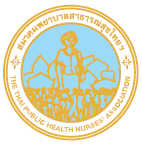Comparison of Urinary Organophosphate Concentrations of Pesticide Sprayers from Sugarcane Farms in Nakhon Sawan Province
Keywords:
Thailand, Pesticide, Sprayer, Organophosphate MetaboliteAbstract
Organophosphates (OP) are synthetic chemicals used as insecticides in agriculture. Pesticide sprayers are at risk of exposure to these chemicals. This research is a cross-sectional study that studied OP metabolite levels of pesticide sprayers of sugarcane farmers, and that compared urinary OP levels related to different times of application. The instruments of this study were a pesticide use questionnaire and collected urine samples. OP levels were determined using gas chromatography-mass spectrometry (GC-MS). The data were represented by mean, standard deviation, geometric mean, median, and repeated analysis of variance.
Results showed most pesticide sprayers used insecticides 2-4 times/ crop and had an average agricultural work time of about 5.79 hours/day. The level of urinary total diethyl phosphate metabolite between the end of a spraying task and the next day of spraying was significantly different (p<0.05). Also, the concentration of the metabolite on the day following spraying was higher. Moreover, the geometric mean of total urinary OP metabolite before the day of spraying was higher than in other periods.
To conclude, pesticide sprayers on sugarcane farms can be exposed to OP from the spraying task. Despite no spraying task, sprayers still had significant OP levels from their residences where there is insecticide use in the household. Pesticide sprayers should incorporate the safe use of OP to decrease the risk of exposure since pesticides accumulate in the body leading to detrimental health effects.
References
Office of the Cane and Sugar Board. Bangkok: Ministry of Industry [internet]. 2020 [cited 2020 October 15]. Available from: http://www.ocsb.go.th/upload/journal/fileupload/923-1854.pdf.
Office of the Cane and Sugar Board. Bangkok: Ministry of Industry [internet]. (-) [cited 2020 October 16]. Available from: http://www.ocsb.go.th/upload/journal/fileupload/144-7354.pdf.
Kongtip P, Nankongnab N, Tipayamongkholgul M, Bunngamchairat A, Yimsabai J, Pataitiemthong A, et al. A Cross-Sectional Investigation of Cardiovascular and Metabolic Biomarkers among Conventional and Organic Farmers in Thailand. Int J Environ Res Public Health 2018; 15(11): 1-12. doi: 10.3390/ijerph15112590.
Gupta RC. CHAPTER 2 - Classification and Uses of Organophosphates and Carbamates. In: Gupta RC, editor. Toxicology of Organophosphate & Carbamate Compounds. Burlington: Academic Press; 2006. p. 5-24.
Poapolathep S. Bangkok: Kasetsart University [internet]. 2016 [cited 2020 October 15]. Available from: http://www.pharmaco.vet.ku.ac.th/pdf_file/Pesticide_20161020.
Centers for Disease Control and Prevention. U.S.A.: U.S. Department of Health & Human Services [internet]. 2017 [cited 2020 October 17]. Available from: https://www.cdc.gov/biomonitoring/OP-DPM_BiomonitoringSummary.html.
Bureau of Occupational and Environmental Disease. Nonthaburi: Ministry of Public Health [internet]. 2019 [cited 2020 March 20]. Available from: http://envocc.ddc.Moph.go.th/.
Health Education Division. Nonthaburi: Ministry of Public Health [internet]. 2019 [cited 2020 October 17]. Available from: http://healthydee.moph.go.th/view_article.php?id=556.
Notification of Ministry of Industry Announcement, List of Toxic chemicals (Vol.6). Rule No. 137, (May 15, 2020) [internet]. 2020 [cited 2020 October 15]. Available from: http://www.ratchakitcha.soc.go.th/DATA/PDF/2563/E/117/T_0056.PDF
Koureas M, Tsakalof A, Tzatzarakis M, Vakonaki E, Tsatsakis A, Hadjichristodoulou C. Biomonitoring of organophosphate exposure of pesticide sprayers and comparison of exposure levels with other population groups in Thessaly (Greece). Occupational and Environmental Medicine 2014; 71(2): 126-33.
Daniel WW, Cross CL. Biostatistics: a foundation for analysis in the health sciences / Wayne W. Daniel, Chad L. Cross: Hoboken, NJ: Wiley, c2013 10th ed.; 2013.
Kongtip P, Nankongnab N, Tipayamongkholgul M, Bunngamchairat A, Yimsabai J, Pataitiemthong A, et al. A Cross-Sectional Investigation of Cardiovascular and Metabolic Biomarkers among Conventional and Organic Farmers in Thailand. Int J Environ Res Public Health 2018; 15(11): 1-12.
Prapamontol T, Sutan K, Laoyang S, Hongsibsong S, Lee G, Yano Y, et al. Cross validation of gas chromatography -flame photometric detection and gas chromatography–mass spectrometry methods for measuring dialkylphosphate metabolites of organophosphate pesticides in human urine. International Journal of Hygiene and Environmental Health 2014; 217(4): 554-66.
Choi J, Moon S, Roh S. The Relationship between Frequency Score of Wearing Personal Protective Equipment and Concentration of Urinary Organophosphorus Pesticide Metabolites in Farmers. Journal of the Korean Environmental Health Society 2019; 45(6): 583-9.
Sapbamrer R, Hongsibsong S, Sittitoon N, et al. Health Impacts of Pesticide Uses: Case Study in Garlic Farmers, Phayao Province. Naresuan University Journal: Science and Technology 2018; 26(1): 20-31.
Panuwet P, Prapamontol T, Chantara S, Thavornyuthikarn P, Montesano MA, Whitehead Jr, et al. Concentrations of urinary pesticide metabolites in small-scale farmers in Chiang Mai Province, Thailand. Sci Total Environ 2008; 407(1): 655-68.
Yucra S, Steenland K, Chung A, Choque F, Gonzales GF. Dialkyl phosphate metabolites of organophosphorus in applicators of agricultural pesticides in Majes - Arequipa (Peru). J Occup Med Toxicol 2006; 1(1): 1-8. doi:10.1186/1745-6673-1-27.
Motsoeneng PM, Dalvie MA. Relationship between Urinary Pesticide Residue Levels and Neurotoxic Symptoms among Women on Farms in the Western Cape, South Africa. International journal of environmental research and public health 2015; 12(6): 6281-99.
Huen K, Bradman A, Harley K, Yousefi P, Boyd Barr D, Eskenazi B, et al. Organophosphate pesticide levels in blood and urine of women and newborns living in an agricultural community. Environmental research 2012; 117: 8-16. doi: 10.1016/j.envres.2012.05.005.
Leuprasert L. Poison Center [Internet]. [cited 2020 August 5]. Available from: http://webdb.dmsc.moph.go.th/ifc_toxic/a_tx_1_001c.asp?info_id=384.
Downloads
Published
How to Cite
Issue
Section
License
บทความที่ตีพิมพ์และแผนภูมิรูปภาพถือเป็นลิขสิทธิ์ของวารสารพยาบาลสาธารณสุข (Thai Public Health Nurses Association)






